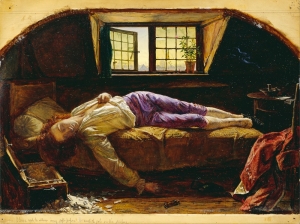They say that a picture paints a thousand words. Apparently, some of those words make up medical diagnoses, as students at the Yale School of Medicine are learning. An innovative educational program is taking students to the Yale Center for British Art for a lesson in using visual cues to improve their observation skills and, ultimately, their diagnosis skills.
It turns out that many of the Old Masters’ works include portrait details that may reveal a wealth of information about the subjects’ health and medical conditions. A perfect example involves a thorough examination of an 1856 painting by English Pre-Raphaelite painter Henry Wallis. At first glance, the young man in the painting seems to be simply taking a nap. But looking closer, young medical students notice the man’s ashen complexion; his body’s contortion and the uneven placement of weight on his hip – not a particularly comfortable sleeping position; and scratches on his chest. When asked to consider the setting, they take note of the dim lighting, as well as scattered pieces of paper and – the ultimate telltale sign – an empty vial on the floor.
Only after an interactive discussion do students learn the painting’s title and its real-world inspiration. The Death of Chatterton depicts the scene of the August, 1770 suicide of Thomas Chatterton by arsenic poisoning. Chatterton was an English poet and forger of pseudo-medieval poetry whose works had a significant impact on the Romantic Movement after his death.
The exercise has been a required part of the curriculum at Yale School of Medicine for just over a decade and is increasingly is being adopted by other medical schools via partnerships with area art museums. Yale’s program became mandatory for first-year students after a 2001 study showed that scores on observation tests increased by nine percent among students who participated in just a one-day gallery session.
“Anyone can type a bunch of symptoms into Google and come up with a diagnosis,” Ben Lerner, a second-year medical student at Yale, told AAMC Reporter, a publication of the Association of American Medical Colleges. “It takes much more to be able to elicit all the signs and symptoms and notice things that others don’t notice. This is a very powerful thing, especially with how much technology is coming into medicine these days.”
In some ways, the creative approach illustrates that of WOLFPACC, which nixes conventional memorize-and-recall and instead teaches students how to better understand the body’s five main organ systems and how they relate to each other. From there, they can more effectively diagnose patients’ medical conditions and develop treatment plans.
Paint a beautiful picture of your medical school and career prospects by enrolling in one of WOLFPACC’s med school and test preparation course. Call 904-209-3140 to speak with an enrollment specialist today.




